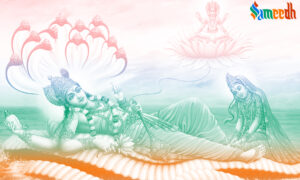The Pancharatra is a Hindu tradition that worships Vishnu as the supreme god. Its origins date to the pre-Christian era, and still today, certain features of it can be found in the related Hindu-tradition of the Shrivaishnavas.

The Pancharatra tradition is one of the major branches of Vaishnavism, a sect within Hinduism devoted to the worship of Lord Vishnu or his avatars (incarnations), particularly Lord Krushna and Lord Ram. The Pancharatra tradition is characterized by its emphasis on deity worship, temple rituals, philosophical teachings, and spiritual practices derived from a group of texts known as the Pancharatra Agamas.
Here are some key aspects of the Pancharatra tradition:
- Pancharatra Agamas: The Pancharatra tradition is based on a group of texts known as the Pancharatra Agamas. These scriptures provide guidelines for deity worship, temple construction, rituals, philosophical understanding, and spiritual disciplines within Vaishnavism. The Agamas are divided into two main categories: Vaikhanasa and Pancharatra.
- Deity Worship: Central to the Pancharatra tradition is the practice of deity worship (archana), wherein devotees establish a personal relationship with the deity through rituals, offerings, prayers, and meditation. The tradition emphasizes the importance of consecrated images or idols of the deity as a means of accessing the divine presence.
- Temple Rituals: Temples play a crucial role in the Pancharatra tradition, serving as sacred spaces for deity worship and community gatherings. Temple rituals, known as agama, are performed according to the guidelines laid out in the Pancharatra Agamas. These rituals include daily worship (puja), elaborate ceremonies (utsavas), and festivals (utsavas) celebrating significant events in the lives of the deities.
- Philosophical Teachings: The Pancharatra tradition incorporates philosophical teachings derived from the Vedas, Upanishads, and other Vaishnava scriptures. It emphasizes the concepts of bhakti (devotion), karma (action), jnana (knowledge), and yoga (spiritual practice) as means of attaining spiritual liberation (moksha) and union with the divine.
- Panentheism: The Pancharatra tradition subscribes to the philosophy of panentheism, which teaches that the divine (Brahman) exists both transcendentally and immanently within the universe. According to this worldview, the Supreme Being (Paramatman) is simultaneously distinct from and pervades all creation, including the individual souls (jivas) and material nature (prakriti).
- Community and Sects: The Pancharatra tradition has given rise to various sects and sub-traditions within Vaishnavism, each with its own interpretations, practices, and rituals. Some of the prominent Pancharatra sects include the Sri Vaishnava Sampradaya, the Pushtimarg tradition, and the Gaudiya Vaishnavism of Chaitanya Mahaprabhu.
Overall, the Pancharatra tradition of Vaishnavism is characterized by its emphasis on deity worship, temple rituals, philosophical teachings, and spiritual practices derived from the Pancharatra Agamas. It continues to be an influential and beloved tradition within Hinduism, attracting devotees seeking spiritual nourishment through the path of loving devotion to God.